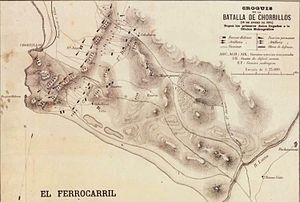Battle of San Juan and Chorrillos
| Battle of San Juan | |||||||
|---|---|---|---|---|---|---|---|
| Part of War of the Pacific | |||||||
 Troop movements at Chorrillos |
|||||||
|
|||||||
| Belligerents | |||||||
|
|
|
||||||
| Commanders and leaders | |||||||
| General Manuel Baquedano | Supreme Chief Nicolás de Piérola | ||||||
| Strength | |||||||
| 30,000 men | 10,000 men | ||||||
| Casualties and losses | |||||||
| 3,107 between dead and wounded | 8,000 casualties: 1,500 dead 2.500 wounded 4,000 prisoners |
||||||
The Battle of San Juan, also known as the Battle of San Juan and Chorrillos, was the first of two battles in the Lima Campaign during the War of the Pacific, and was fought on January 13, 1881. This battle is really a group of smaller, yet fierce confrontations at the defensive strongholds of Villa, Chorrillos, Santiago de Surco, San Juan de Miraflores, Santa Teresa and Morro Solar. The Chilean army led by Gen. Manuel Baquedano inflicted a harsh defeat on the Peruvian army commanded by the Supreme Chief Nicolás de Piérola. The Chilean triumph eliminated the first defensive line guarding Lima, and almost obliterated the Peruvian army defending it.
At the end of the battle, the town of Chorrillos was burnt to the ground by the Chilean army trying to eradicate the Peruvian defenders garrisoned there. During the night, civilian abuses were committed by drunk soldiers.
Despite this result, another battle had to be fought in order that the Chilean army could enter the Peruvian capital city at Miraflores, two days later.
After the Chilean victories at the battles of Tacna and Arica, the southern department of Peru was on Chilean hands, so the Chilean government had no desire to continue the war. After all, the Bolivian zone in dispute which started the conflict was under Chilean domain, as well as the southernmost Peruvian department of Tarapaca, which was not in dispute but had started to play a significant role in financing the Chilean war effort. Despite this, the public opinion was divided. One side desired to end the war by conquering Lima, and the other one wanted to end the conflict right then, avoiding more casualties. The public debate reached the Chilean Congress, were José Miguel Balmaceda declared: The peace is at Lima, and nowhere else. This political and social climate forced both the Chilean government and its high command to plan a new campaign with the objective to obtain an unconditional capitulation at the Peruvian capital city. Hence, the peace talks on the Lackwanna known as the Conference of Arica were futile.
...
Wikipedia
